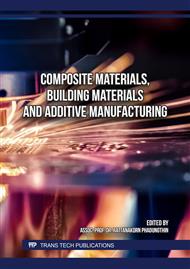p.29
p.41
p.49
p.61
p.67
p.75
p.85
p.99
p.109
Stabilizer Effects on the Gelation of Modified Recycled PET for 3D Printing Filament Application
Abstract:
This research identification gel types of the modified-recycled poly (ethylene terephthalate) (modified-rPET) filament, with and without the addition of heat stabilizer Pentaerythritol tetrakis(3-(3,5-di-tert-butyl-4-hydroxyphenyl) propionate (Irganox®1010). This research also identifies the gel types and studies thermal behavior of the modified-rPET filaments above, by using a hot-stage microscopy, and a differential scanning calorimetry, respectively. rPET flakes were dried to deplete the moisture. Then, they were mixed with additives and heat stabilizer (Irganox®1010) at 0 and 0.5 pph, Then, they were extruded to be compound using twin screw extruder. The compounds were extruded into filament by using filament extruder. The two temperature profiles were used. The first and the second temperature profiles from the feed zone to the die zone were 275-275-275 oC and 290-290-290 oC, respectively. The extrudate of modified-rPET with and without heat stabilizer, were investigated the type of gel and the thermal behavior of the modified-rPET filament. From this preliminary experiment, it was found that the “unmelt-gel” defect was found from the modified-rPET filament, without the addition of Irganox®1010. On the other hand, the “crosslinked gel” defect was found from the modified-rPET filament, with the addition of Irganox®1010. Therefore, the addition of heat stabilizer (Irganox®1010) may cause the “crosslinked gel” significantly. Our future work, we will investigate the effect of another stabilizer and chain extenders on the gelation behavior, to complete this clarification systematically.
Info:
Periodical:
Pages:
67-73
Citation:
Online since:
November 2024
Price:
Сopyright:
© 2024 Trans Tech Publications Ltd. All Rights Reserved
Share:
Citation:



